Report: Analyzing the Dividend Policy of Kellogg's Corporation
VerifiedAdded on 2021/05/17
|13
|2955
|41
Report
AI Summary
This report provides a comprehensive analysis of Kellogg's dividend policy, examining its significance for investors and its impact on the company's financial performance. The report reviews Kellogg's dividend yield, its turnaround plan, and the determinants influencing its dividend policy. It delves into the company's current financial situation, including its debt levels and strategic acquisitions, and assesses the effects of its dividend policy on its future growth prospects. The report also explores Kellogg's future policies, including its global commitment to address hunger and promote sustainability. The analysis considers the company's past dividend payments, future dividend development, and the factors influencing its dividend strategy, offering insights into the company's financial health and investment potential.
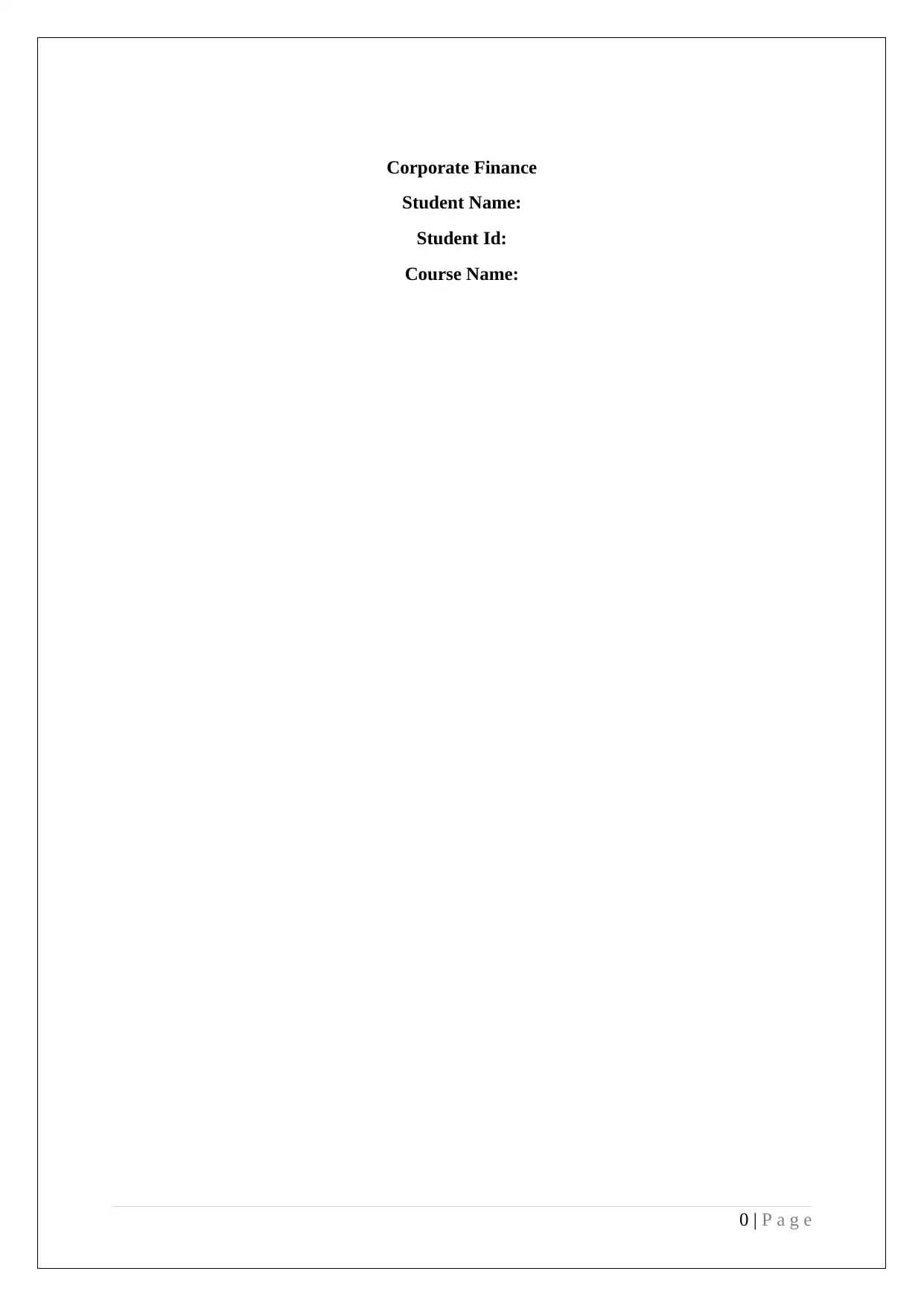
Corporate Finance
Student Name:
Student Id:
Course Name:
0 | P a g e
Student Name:
Student Id:
Course Name:
0 | P a g e
Paraphrase This Document
Need a fresh take? Get an instant paraphrase of this document with our AI Paraphraser
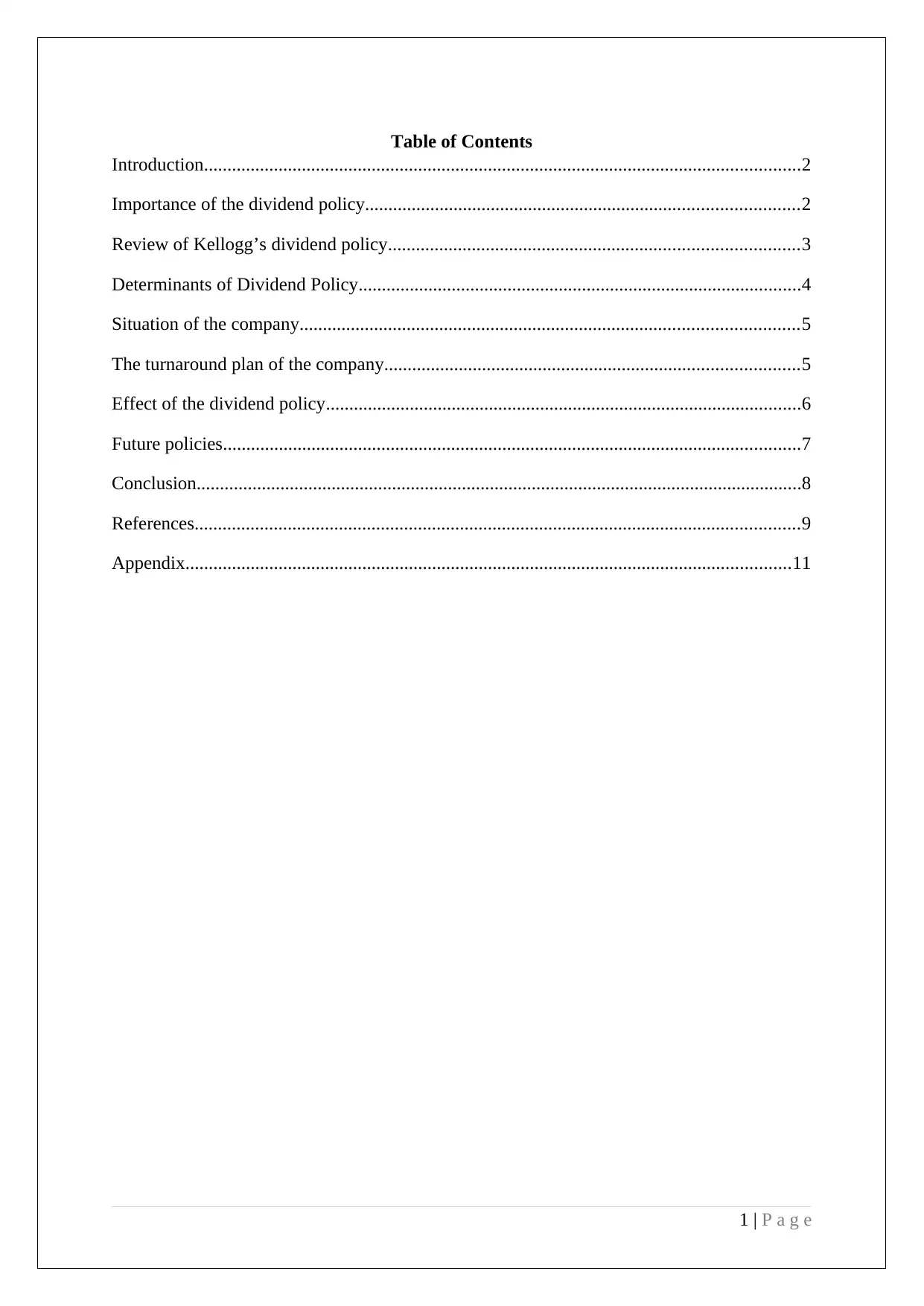
Table of Contents
Introduction................................................................................................................................2
Importance of the dividend policy.............................................................................................2
Review of Kellogg’s dividend policy........................................................................................3
Determinants of Dividend Policy...............................................................................................4
Situation of the company...........................................................................................................5
The turnaround plan of the company.........................................................................................5
Effect of the dividend policy......................................................................................................6
Future policies............................................................................................................................7
Conclusion..................................................................................................................................8
References..................................................................................................................................9
Appendix..................................................................................................................................11
1 | P a g e
Introduction................................................................................................................................2
Importance of the dividend policy.............................................................................................2
Review of Kellogg’s dividend policy........................................................................................3
Determinants of Dividend Policy...............................................................................................4
Situation of the company...........................................................................................................5
The turnaround plan of the company.........................................................................................5
Effect of the dividend policy......................................................................................................6
Future policies............................................................................................................................7
Conclusion..................................................................................................................................8
References..................................................................................................................................9
Appendix..................................................................................................................................11
1 | P a g e
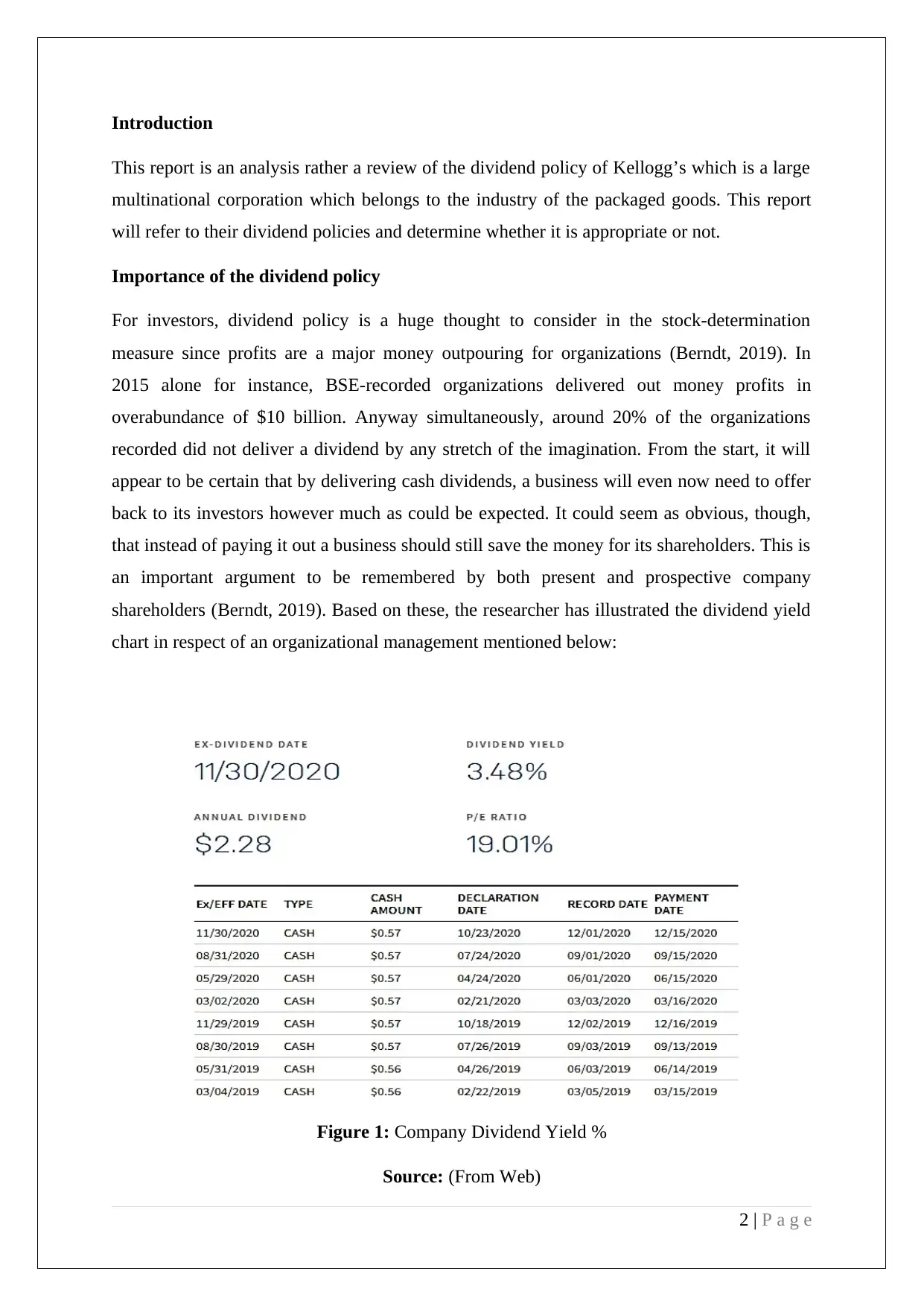
Introduction
This report is an analysis rather a review of the dividend policy of Kellogg’s which is a large
multinational corporation which belongs to the industry of the packaged goods. This report
will refer to their dividend policies and determine whether it is appropriate or not.
Importance of the dividend policy
For investors, dividend policy is a huge thought to consider in the stock-determination
measure since profits are a major money outpouring for organizations (Berndt, 2019). In
2015 alone for instance, BSE-recorded organizations delivered out money profits in
overabundance of $10 billion. Anyway simultaneously, around 20% of the organizations
recorded did not deliver a dividend by any stretch of the imagination. From the start, it will
appear to be certain that by delivering cash dividends, a business will even now need to offer
back to its investors however much as could be expected. It could seem as obvious, though,
that instead of paying it out a business should still save the money for its shareholders. This is
an important argument to be remembered by both present and prospective company
shareholders (Berndt, 2019). Based on these, the researcher has illustrated the dividend yield
chart in respect of an organizational management mentioned below:
Figure 1: Company Dividend Yield %
Source: (From Web)
2 | P a g e
This report is an analysis rather a review of the dividend policy of Kellogg’s which is a large
multinational corporation which belongs to the industry of the packaged goods. This report
will refer to their dividend policies and determine whether it is appropriate or not.
Importance of the dividend policy
For investors, dividend policy is a huge thought to consider in the stock-determination
measure since profits are a major money outpouring for organizations (Berndt, 2019). In
2015 alone for instance, BSE-recorded organizations delivered out money profits in
overabundance of $10 billion. Anyway simultaneously, around 20% of the organizations
recorded did not deliver a dividend by any stretch of the imagination. From the start, it will
appear to be certain that by delivering cash dividends, a business will even now need to offer
back to its investors however much as could be expected. It could seem as obvious, though,
that instead of paying it out a business should still save the money for its shareholders. This is
an important argument to be remembered by both present and prospective company
shareholders (Berndt, 2019). Based on these, the researcher has illustrated the dividend yield
chart in respect of an organizational management mentioned below:
Figure 1: Company Dividend Yield %
Source: (From Web)
2 | P a g e
⊘ This is a preview!⊘
Do you want full access?
Subscribe today to unlock all pages.

Trusted by 1+ million students worldwide
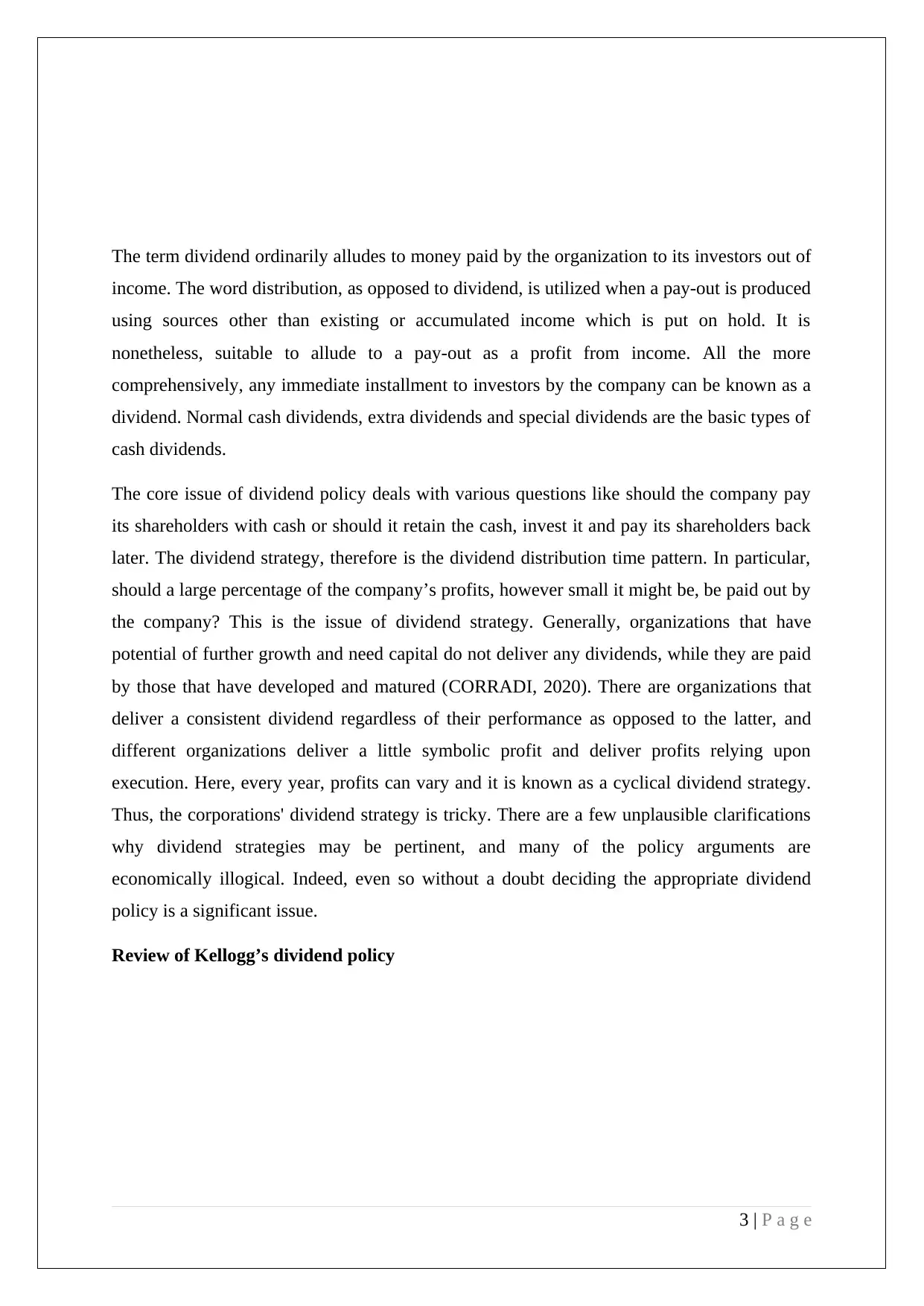
The term dividend ordinarily alludes to money paid by the organization to its investors out of
income. The word distribution, as opposed to dividend, is utilized when a pay-out is produced
using sources other than existing or accumulated income which is put on hold. It is
nonetheless, suitable to allude to a pay-out as a profit from income. All the more
comprehensively, any immediate installment to investors by the company can be known as a
dividend. Normal cash dividends, extra dividends and special dividends are the basic types of
cash dividends.
The core issue of dividend policy deals with various questions like should the company pay
its shareholders with cash or should it retain the cash, invest it and pay its shareholders back
later. The dividend strategy, therefore is the dividend distribution time pattern. In particular,
should a large percentage of the company’s profits, however small it might be, be paid out by
the company? This is the issue of dividend strategy. Generally, organizations that have
potential of further growth and need capital do not deliver any dividends, while they are paid
by those that have developed and matured (CORRADI, 2020). There are organizations that
deliver a consistent dividend regardless of their performance as opposed to the latter, and
different organizations deliver a little symbolic profit and deliver profits relying upon
execution. Here, every year, profits can vary and it is known as a cyclical dividend strategy.
Thus, the corporations' dividend strategy is tricky. There are a few unplausible clarifications
why dividend strategies may be pertinent, and many of the policy arguments are
economically illogical. Indeed, even so without a doubt deciding the appropriate dividend
policy is a significant issue.
Review of Kellogg’s dividend policy
3 | P a g e
income. The word distribution, as opposed to dividend, is utilized when a pay-out is produced
using sources other than existing or accumulated income which is put on hold. It is
nonetheless, suitable to allude to a pay-out as a profit from income. All the more
comprehensively, any immediate installment to investors by the company can be known as a
dividend. Normal cash dividends, extra dividends and special dividends are the basic types of
cash dividends.
The core issue of dividend policy deals with various questions like should the company pay
its shareholders with cash or should it retain the cash, invest it and pay its shareholders back
later. The dividend strategy, therefore is the dividend distribution time pattern. In particular,
should a large percentage of the company’s profits, however small it might be, be paid out by
the company? This is the issue of dividend strategy. Generally, organizations that have
potential of further growth and need capital do not deliver any dividends, while they are paid
by those that have developed and matured (CORRADI, 2020). There are organizations that
deliver a consistent dividend regardless of their performance as opposed to the latter, and
different organizations deliver a little symbolic profit and deliver profits relying upon
execution. Here, every year, profits can vary and it is known as a cyclical dividend strategy.
Thus, the corporations' dividend strategy is tricky. There are a few unplausible clarifications
why dividend strategies may be pertinent, and many of the policy arguments are
economically illogical. Indeed, even so without a doubt deciding the appropriate dividend
policy is a significant issue.
Review of Kellogg’s dividend policy
3 | P a g e
Paraphrase This Document
Need a fresh take? Get an instant paraphrase of this document with our AI Paraphraser
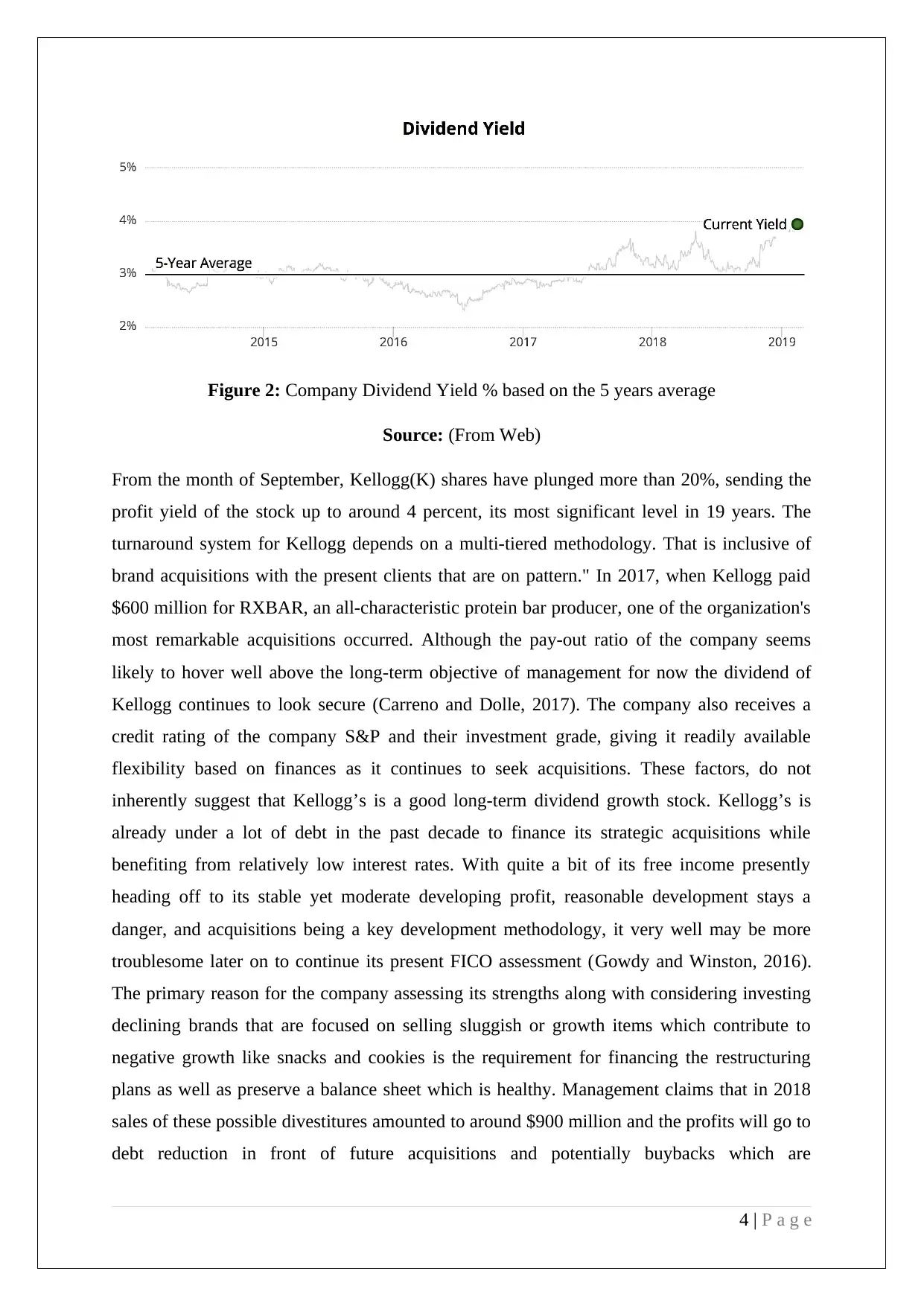
Figure 2: Company Dividend Yield % based on the 5 years average
Source: (From Web)
From the month of September, Kellogg(K) shares have plunged more than 20%, sending the
profit yield of the stock up to around 4 percent, its most significant level in 19 years. The
turnaround system for Kellogg depends on a multi-tiered methodology. That is inclusive of
brand acquisitions with the present clients that are on pattern." In 2017, when Kellogg paid
$600 million for RXBAR, an all-characteristic protein bar producer, one of the organization's
most remarkable acquisitions occurred. Although the pay-out ratio of the company seems
likely to hover well above the long-term objective of management for now the dividend of
Kellogg continues to look secure (Carreno and Dolle, 2017). The company also receives a
credit rating of the company S&P and their investment grade, giving it readily available
flexibility based on finances as it continues to seek acquisitions. These factors, do not
inherently suggest that Kellogg’s is a good long-term dividend growth stock. Kellogg’s is
already under a lot of debt in the past decade to finance its strategic acquisitions while
benefiting from relatively low interest rates. With quite a bit of its free income presently
heading off to its stable yet moderate developing profit, reasonable development stays a
danger, and acquisitions being a key development methodology, it very well may be more
troublesome later on to continue its present FICO assessment (Gowdy and Winston, 2016).
The primary reason for the company assessing its strengths along with considering investing
declining brands that are focused on selling sluggish or growth items which contribute to
negative growth like snacks and cookies is the requirement for financing the restructuring
plans as well as preserve a balance sheet which is healthy. Management claims that in 2018
sales of these possible divestitures amounted to around $900 million and the profits will go to
debt reduction in front of future acquisitions and potentially buybacks which are
4 | P a g e
Source: (From Web)
From the month of September, Kellogg(K) shares have plunged more than 20%, sending the
profit yield of the stock up to around 4 percent, its most significant level in 19 years. The
turnaround system for Kellogg depends on a multi-tiered methodology. That is inclusive of
brand acquisitions with the present clients that are on pattern." In 2017, when Kellogg paid
$600 million for RXBAR, an all-characteristic protein bar producer, one of the organization's
most remarkable acquisitions occurred. Although the pay-out ratio of the company seems
likely to hover well above the long-term objective of management for now the dividend of
Kellogg continues to look secure (Carreno and Dolle, 2017). The company also receives a
credit rating of the company S&P and their investment grade, giving it readily available
flexibility based on finances as it continues to seek acquisitions. These factors, do not
inherently suggest that Kellogg’s is a good long-term dividend growth stock. Kellogg’s is
already under a lot of debt in the past decade to finance its strategic acquisitions while
benefiting from relatively low interest rates. With quite a bit of its free income presently
heading off to its stable yet moderate developing profit, reasonable development stays a
danger, and acquisitions being a key development methodology, it very well may be more
troublesome later on to continue its present FICO assessment (Gowdy and Winston, 2016).
The primary reason for the company assessing its strengths along with considering investing
declining brands that are focused on selling sluggish or growth items which contribute to
negative growth like snacks and cookies is the requirement for financing the restructuring
plans as well as preserve a balance sheet which is healthy. Management claims that in 2018
sales of these possible divestitures amounted to around $900 million and the profits will go to
debt reduction in front of future acquisitions and potentially buybacks which are
4 | P a g e
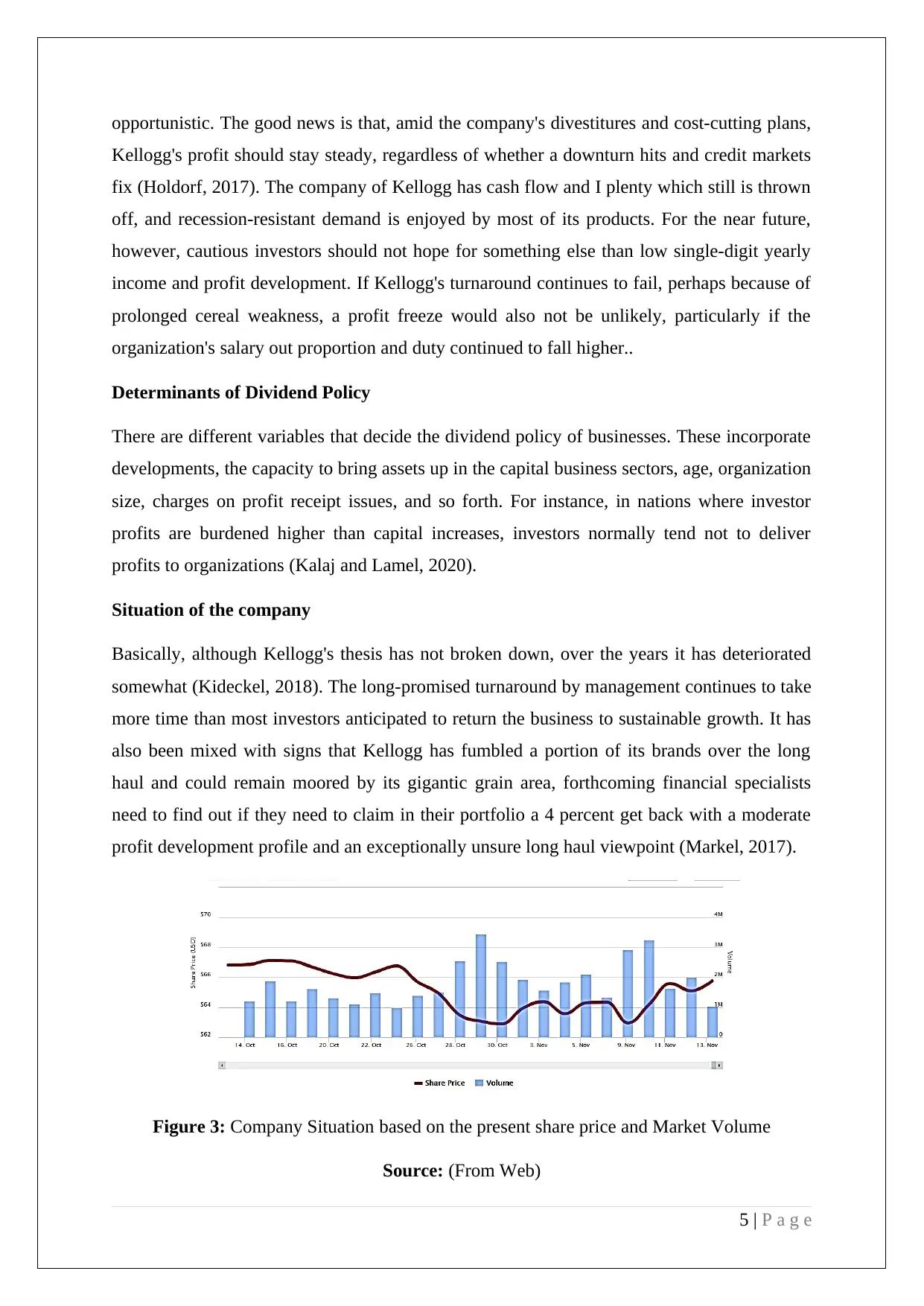
opportunistic. The good news is that, amid the company's divestitures and cost-cutting plans,
Kellogg's profit should stay steady, regardless of whether a downturn hits and credit markets
fix (Holdorf, 2017). The company of Kellogg has cash flow and I plenty which still is thrown
off, and recession-resistant demand is enjoyed by most of its products. For the near future,
however, cautious investors should not hope for something else than low single-digit yearly
income and profit development. If Kellogg's turnaround continues to fail, perhaps because of
prolonged cereal weakness, a profit freeze would also not be unlikely, particularly if the
organization's salary out proportion and duty continued to fall higher..
Determinants of Dividend Policy
There are different variables that decide the dividend policy of businesses. These incorporate
developments, the capacity to bring assets up in the capital business sectors, age, organization
size, charges on profit receipt issues, and so forth. For instance, in nations where investor
profits are burdened higher than capital increases, investors normally tend not to deliver
profits to organizations (Kalaj and Lamel, 2020).
Situation of the company
Basically, although Kellogg's thesis has not broken down, over the years it has deteriorated
somewhat (Kideckel, 2018). The long-promised turnaround by management continues to take
more time than most investors anticipated to return the business to sustainable growth. It has
also been mixed with signs that Kellogg has fumbled a portion of its brands over the long
haul and could remain moored by its gigantic grain area, forthcoming financial specialists
need to find out if they need to claim in their portfolio a 4 percent get back with a moderate
profit development profile and an exceptionally unsure long haul viewpoint (Markel, 2017).
Figure 3: Company Situation based on the present share price and Market Volume
Source: (From Web)
5 | P a g e
Kellogg's profit should stay steady, regardless of whether a downturn hits and credit markets
fix (Holdorf, 2017). The company of Kellogg has cash flow and I plenty which still is thrown
off, and recession-resistant demand is enjoyed by most of its products. For the near future,
however, cautious investors should not hope for something else than low single-digit yearly
income and profit development. If Kellogg's turnaround continues to fail, perhaps because of
prolonged cereal weakness, a profit freeze would also not be unlikely, particularly if the
organization's salary out proportion and duty continued to fall higher..
Determinants of Dividend Policy
There are different variables that decide the dividend policy of businesses. These incorporate
developments, the capacity to bring assets up in the capital business sectors, age, organization
size, charges on profit receipt issues, and so forth. For instance, in nations where investor
profits are burdened higher than capital increases, investors normally tend not to deliver
profits to organizations (Kalaj and Lamel, 2020).
Situation of the company
Basically, although Kellogg's thesis has not broken down, over the years it has deteriorated
somewhat (Kideckel, 2018). The long-promised turnaround by management continues to take
more time than most investors anticipated to return the business to sustainable growth. It has
also been mixed with signs that Kellogg has fumbled a portion of its brands over the long
haul and could remain moored by its gigantic grain area, forthcoming financial specialists
need to find out if they need to claim in their portfolio a 4 percent get back with a moderate
profit development profile and an exceptionally unsure long haul viewpoint (Markel, 2017).
Figure 3: Company Situation based on the present share price and Market Volume
Source: (From Web)
5 | P a g e
⊘ This is a preview!⊘
Do you want full access?
Subscribe today to unlock all pages.

Trusted by 1+ million students worldwide

The turnaround plan of the company
The turnaround system for Kellogg depends on a multi-pronged methodology. That is
inclusive of brand acquisitions with the present clients that are on pattern." In 2017, when
Kellogg paid $600 million for RXBAR, an all-characteristic protein bar producer, one of the
organization's most remarkable acquisitions occurred (Markel, 2017). Meanwhile the firm is
currently experiencing respectable organic growth in international markets, inclusive of:
Europe has 3% thanks to Pringles' introduction and the extension to the Middle East
as well as Russia
7% regarded to be in America (Latin) (Lazar, 2018)
In Asia Pacific, 5 percent
In reality, a higher extent of Kellogg's income is created from developing business sectors
than everything except two of its friends, thanks partially to a $420 million arrangement in
2018 to develop its African area. But only two aspects of a three-pronged plan to return the
business to sustainable growth are aimed at stronger overseas growth and expanding its
healthier products. The last angle is reduction in cost, explicitly "Venture K," acquainted in
2013 and planned with both smooth out the gracefully chain of Kellogg, just as make it
simpler to consolidate its better performing brands into new item dispatches (Sethi and Bafna,
2018). The aim of management was to cut costs by $475 million due to these efforts (Markel,
2017). In 2017, Kellogg’s likewise moved from an immediate store conveyance model to one
focused on stockrooms (like a large portion of its opponents use for around 25 percent of its
items. This diminished working costs by around $650 million toward the finish of 2019,
reflecting around a 6 percent decrease in the expense of merchandise sold. Over the long
haul, the executives anticipate that a reshuffling of its brands, joined with more grounded
development abroad and progressing cost-reduction exercises, will assist in changing EPS as
well as profit development of 7% in an annual period. It is anticipated that profitable growth
will be powered by a greater emphasis on snacks, solidified nourishments and developing
business sectors, which are all normal to ascend at a low-to-mid single-digit rate, while oats
are required to stay stable.
6 | P a g e
The turnaround system for Kellogg depends on a multi-pronged methodology. That is
inclusive of brand acquisitions with the present clients that are on pattern." In 2017, when
Kellogg paid $600 million for RXBAR, an all-characteristic protein bar producer, one of the
organization's most remarkable acquisitions occurred (Markel, 2017). Meanwhile the firm is
currently experiencing respectable organic growth in international markets, inclusive of:
Europe has 3% thanks to Pringles' introduction and the extension to the Middle East
as well as Russia
7% regarded to be in America (Latin) (Lazar, 2018)
In Asia Pacific, 5 percent
In reality, a higher extent of Kellogg's income is created from developing business sectors
than everything except two of its friends, thanks partially to a $420 million arrangement in
2018 to develop its African area. But only two aspects of a three-pronged plan to return the
business to sustainable growth are aimed at stronger overseas growth and expanding its
healthier products. The last angle is reduction in cost, explicitly "Venture K," acquainted in
2013 and planned with both smooth out the gracefully chain of Kellogg, just as make it
simpler to consolidate its better performing brands into new item dispatches (Sethi and Bafna,
2018). The aim of management was to cut costs by $475 million due to these efforts (Markel,
2017). In 2017, Kellogg’s likewise moved from an immediate store conveyance model to one
focused on stockrooms (like a large portion of its opponents use for around 25 percent of its
items. This diminished working costs by around $650 million toward the finish of 2019,
reflecting around a 6 percent decrease in the expense of merchandise sold. Over the long
haul, the executives anticipate that a reshuffling of its brands, joined with more grounded
development abroad and progressing cost-reduction exercises, will assist in changing EPS as
well as profit development of 7% in an annual period. It is anticipated that profitable growth
will be powered by a greater emphasis on snacks, solidified nourishments and developing
business sectors, which are all normal to ascend at a low-to-mid single-digit rate, while oats
are required to stay stable.
6 | P a g e
Paraphrase This Document
Need a fresh take? Get an instant paraphrase of this document with our AI Paraphraser
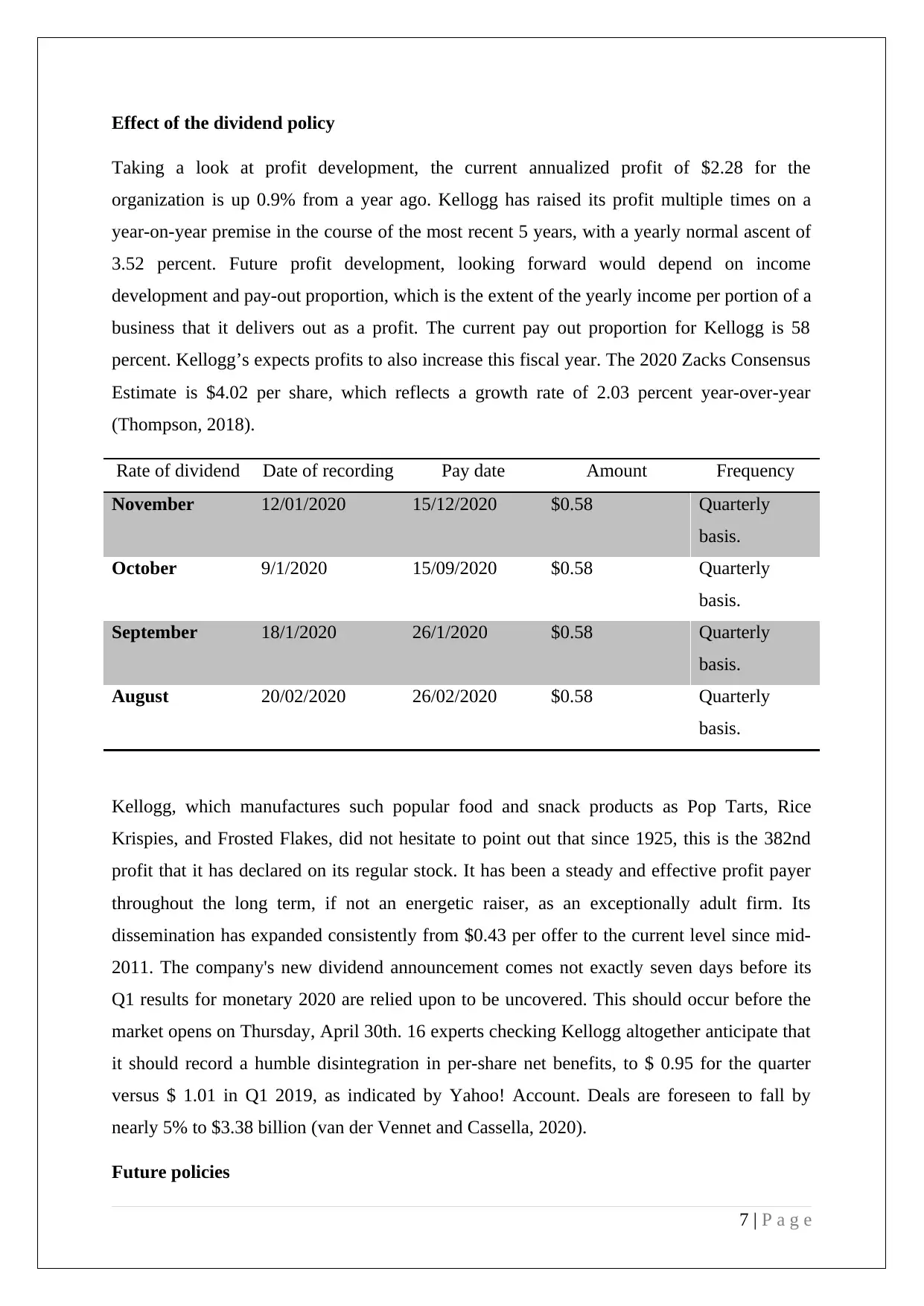
Effect of the dividend policy
Taking a look at profit development, the current annualized profit of $2.28 for the
organization is up 0.9% from a year ago. Kellogg has raised its profit multiple times on a
year-on-year premise in the course of the most recent 5 years, with a yearly normal ascent of
3.52 percent. Future profit development, looking forward would depend on income
development and pay-out proportion, which is the extent of the yearly income per portion of a
business that it delivers out as a profit. The current pay out proportion for Kellogg is 58
percent. Kellogg’s expects profits to also increase this fiscal year. The 2020 Zacks Consensus
Estimate is $4.02 per share, which reflects a growth rate of 2.03 percent year-over-year
(Thompson, 2018).
Rate of dividend Date of recording Pay date Amount Frequency
November 12/01/2020 15/12/2020 $0.58 Quarterly
basis.
October 9/1/2020 15/09/2020 $0.58 Quarterly
basis.
September 18/1/2020 26/1/2020 $0.58 Quarterly
basis.
August 20/02/2020 26/02/2020 $0.58 Quarterly
basis.
Kellogg, which manufactures such popular food and snack products as Pop Tarts, Rice
Krispies, and Frosted Flakes, did not hesitate to point out that since 1925, this is the 382nd
profit that it has declared on its regular stock. It has been a steady and effective profit payer
throughout the long term, if not an energetic raiser, as an exceptionally adult firm. Its
dissemination has expanded consistently from $0.43 per offer to the current level since mid-
2011. The company's new dividend announcement comes not exactly seven days before its
Q1 results for monetary 2020 are relied upon to be uncovered. This should occur before the
market opens on Thursday, April 30th. 16 experts checking Kellogg altogether anticipate that
it should record a humble disintegration in per-share net benefits, to $ 0.95 for the quarter
versus $ 1.01 in Q1 2019, as indicated by Yahoo! Account. Deals are foreseen to fall by
nearly 5% to $3.38 billion (van der Vennet and Cassella, 2020).
Future policies
7 | P a g e
Taking a look at profit development, the current annualized profit of $2.28 for the
organization is up 0.9% from a year ago. Kellogg has raised its profit multiple times on a
year-on-year premise in the course of the most recent 5 years, with a yearly normal ascent of
3.52 percent. Future profit development, looking forward would depend on income
development and pay-out proportion, which is the extent of the yearly income per portion of a
business that it delivers out as a profit. The current pay out proportion for Kellogg is 58
percent. Kellogg’s expects profits to also increase this fiscal year. The 2020 Zacks Consensus
Estimate is $4.02 per share, which reflects a growth rate of 2.03 percent year-over-year
(Thompson, 2018).
Rate of dividend Date of recording Pay date Amount Frequency
November 12/01/2020 15/12/2020 $0.58 Quarterly
basis.
October 9/1/2020 15/09/2020 $0.58 Quarterly
basis.
September 18/1/2020 26/1/2020 $0.58 Quarterly
basis.
August 20/02/2020 26/02/2020 $0.58 Quarterly
basis.
Kellogg, which manufactures such popular food and snack products as Pop Tarts, Rice
Krispies, and Frosted Flakes, did not hesitate to point out that since 1925, this is the 382nd
profit that it has declared on its regular stock. It has been a steady and effective profit payer
throughout the long term, if not an energetic raiser, as an exceptionally adult firm. Its
dissemination has expanded consistently from $0.43 per offer to the current level since mid-
2011. The company's new dividend announcement comes not exactly seven days before its
Q1 results for monetary 2020 are relied upon to be uncovered. This should occur before the
market opens on Thursday, April 30th. 16 experts checking Kellogg altogether anticipate that
it should record a humble disintegration in per-share net benefits, to $ 0.95 for the quarter
versus $ 1.01 in Q1 2019, as indicated by Yahoo! Account. Deals are foreseen to fall by
nearly 5% to $3.38 billion (van der Vennet and Cassella, 2020).
Future policies
7 | P a g e
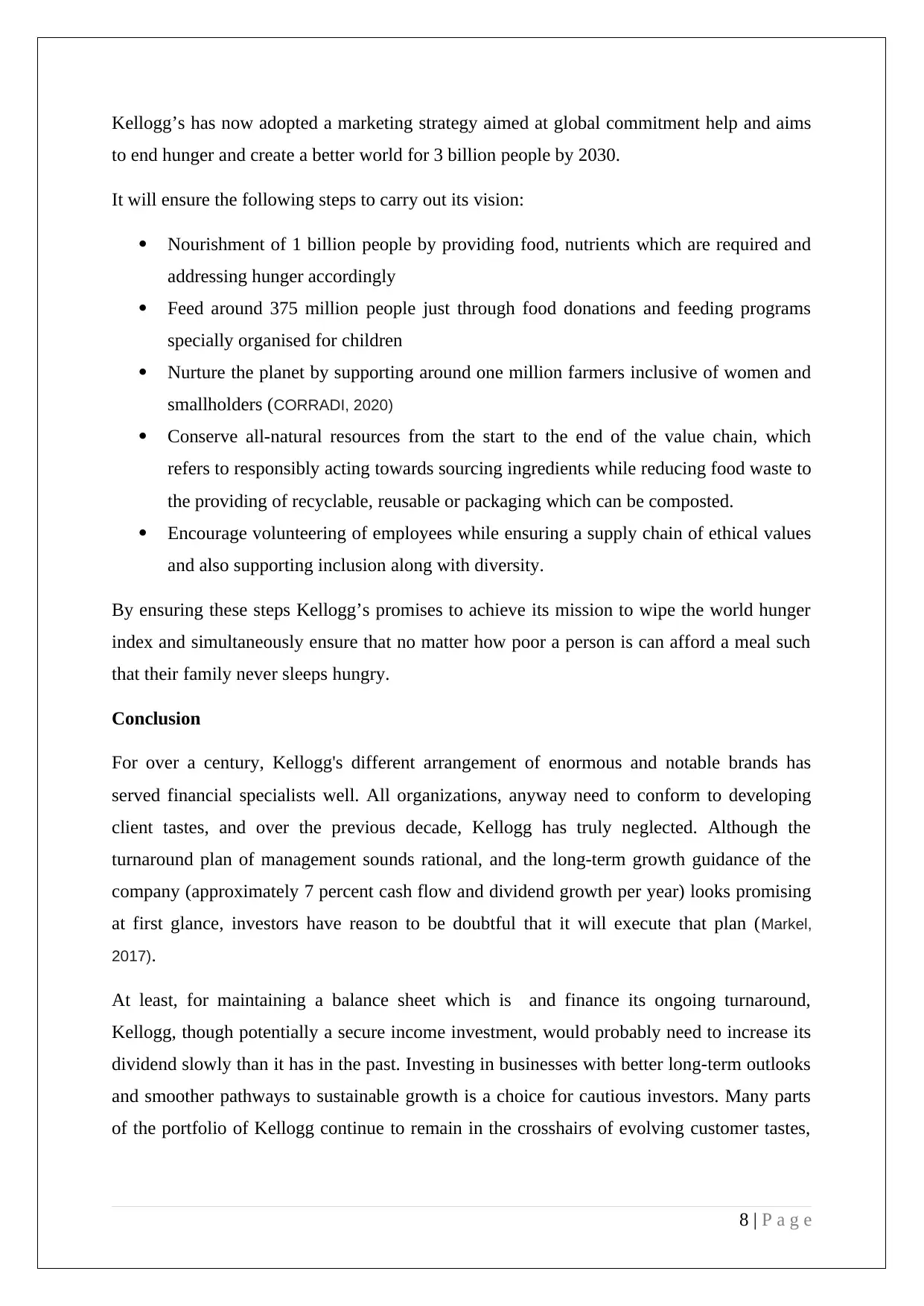
Kellogg’s has now adopted a marketing strategy aimed at global commitment help and aims
to end hunger and create a better world for 3 billion people by 2030.
It will ensure the following steps to carry out its vision:
Nourishment of 1 billion people by providing food, nutrients which are required and
addressing hunger accordingly
Feed around 375 million people just through food donations and feeding programs
specially organised for children
Nurture the planet by supporting around one million farmers inclusive of women and
smallholders (CORRADI, 2020)
Conserve all-natural resources from the start to the end of the value chain, which
refers to responsibly acting towards sourcing ingredients while reducing food waste to
the providing of recyclable, reusable or packaging which can be composted.
Encourage volunteering of employees while ensuring a supply chain of ethical values
and also supporting inclusion along with diversity.
By ensuring these steps Kellogg’s promises to achieve its mission to wipe the world hunger
index and simultaneously ensure that no matter how poor a person is can afford a meal such
that their family never sleeps hungry.
Conclusion
For over a century, Kellogg's different arrangement of enormous and notable brands has
served financial specialists well. All organizations, anyway need to conform to developing
client tastes, and over the previous decade, Kellogg has truly neglected. Although the
turnaround plan of management sounds rational, and the long-term growth guidance of the
company (approximately 7 percent cash flow and dividend growth per year) looks promising
at first glance, investors have reason to be doubtful that it will execute that plan (Markel,
2017).
At least, for maintaining a balance sheet which is and finance its ongoing turnaround,
Kellogg, though potentially a secure income investment, would probably need to increase its
dividend slowly than it has in the past. Investing in businesses with better long-term outlooks
and smoother pathways to sustainable growth is a choice for cautious investors. Many parts
of the portfolio of Kellogg continue to remain in the crosshairs of evolving customer tastes,
8 | P a g e
to end hunger and create a better world for 3 billion people by 2030.
It will ensure the following steps to carry out its vision:
Nourishment of 1 billion people by providing food, nutrients which are required and
addressing hunger accordingly
Feed around 375 million people just through food donations and feeding programs
specially organised for children
Nurture the planet by supporting around one million farmers inclusive of women and
smallholders (CORRADI, 2020)
Conserve all-natural resources from the start to the end of the value chain, which
refers to responsibly acting towards sourcing ingredients while reducing food waste to
the providing of recyclable, reusable or packaging which can be composted.
Encourage volunteering of employees while ensuring a supply chain of ethical values
and also supporting inclusion along with diversity.
By ensuring these steps Kellogg’s promises to achieve its mission to wipe the world hunger
index and simultaneously ensure that no matter how poor a person is can afford a meal such
that their family never sleeps hungry.
Conclusion
For over a century, Kellogg's different arrangement of enormous and notable brands has
served financial specialists well. All organizations, anyway need to conform to developing
client tastes, and over the previous decade, Kellogg has truly neglected. Although the
turnaround plan of management sounds rational, and the long-term growth guidance of the
company (approximately 7 percent cash flow and dividend growth per year) looks promising
at first glance, investors have reason to be doubtful that it will execute that plan (Markel,
2017).
At least, for maintaining a balance sheet which is and finance its ongoing turnaround,
Kellogg, though potentially a secure income investment, would probably need to increase its
dividend slowly than it has in the past. Investing in businesses with better long-term outlooks
and smoother pathways to sustainable growth is a choice for cautious investors. Many parts
of the portfolio of Kellogg continue to remain in the crosshairs of evolving customer tastes,
8 | P a g e
⊘ This is a preview!⊘
Do you want full access?
Subscribe today to unlock all pages.

Trusted by 1+ million students worldwide
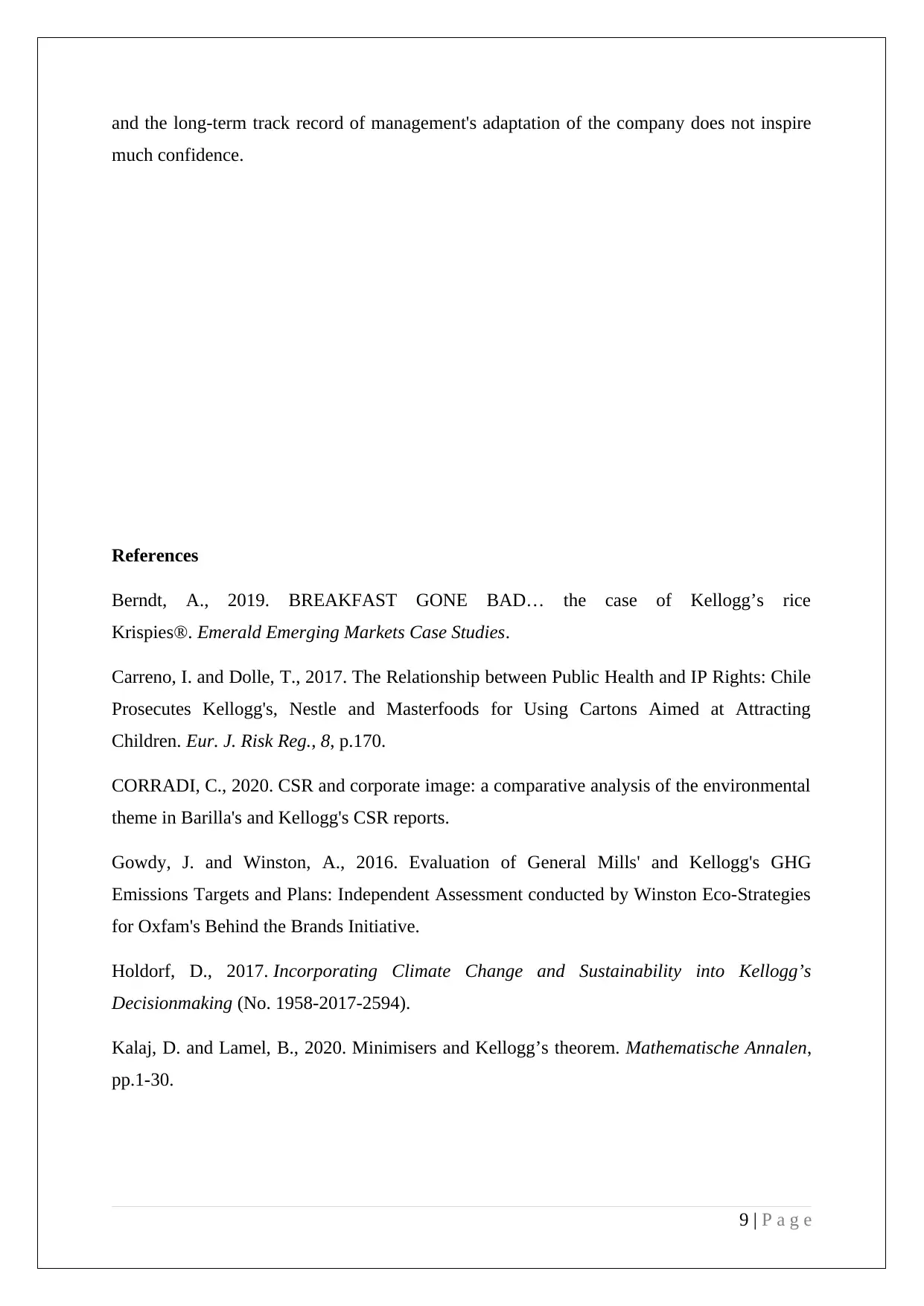
and the long-term track record of management's adaptation of the company does not inspire
much confidence.
References
Berndt, A., 2019. BREAKFAST GONE BAD… the case of Kellogg’s rice
Krispies®. Emerald Emerging Markets Case Studies.
Carreno, I. and Dolle, T., 2017. The Relationship between Public Health and IP Rights: Chile
Prosecutes Kellogg's, Nestle and Masterfoods for Using Cartons Aimed at Attracting
Children. Eur. J. Risk Reg., 8, p.170.
CORRADI, C., 2020. CSR and corporate image: a comparative analysis of the environmental
theme in Barilla's and Kellogg's CSR reports.
Gowdy, J. and Winston, A., 2016. Evaluation of General Mills' and Kellogg's GHG
Emissions Targets and Plans: Independent Assessment conducted by Winston Eco-Strategies
for Oxfam's Behind the Brands Initiative.
Holdorf, D., 2017. Incorporating Climate Change and Sustainability into Kellogg’s
Decisionmaking (No. 1958-2017-2594).
Kalaj, D. and Lamel, B., 2020. Minimisers and Kellogg’s theorem. Mathematische Annalen,
pp.1-30.
9 | P a g e
much confidence.
References
Berndt, A., 2019. BREAKFAST GONE BAD… the case of Kellogg’s rice
Krispies®. Emerald Emerging Markets Case Studies.
Carreno, I. and Dolle, T., 2017. The Relationship between Public Health and IP Rights: Chile
Prosecutes Kellogg's, Nestle and Masterfoods for Using Cartons Aimed at Attracting
Children. Eur. J. Risk Reg., 8, p.170.
CORRADI, C., 2020. CSR and corporate image: a comparative analysis of the environmental
theme in Barilla's and Kellogg's CSR reports.
Gowdy, J. and Winston, A., 2016. Evaluation of General Mills' and Kellogg's GHG
Emissions Targets and Plans: Independent Assessment conducted by Winston Eco-Strategies
for Oxfam's Behind the Brands Initiative.
Holdorf, D., 2017. Incorporating Climate Change and Sustainability into Kellogg’s
Decisionmaking (No. 1958-2017-2594).
Kalaj, D. and Lamel, B., 2020. Minimisers and Kellogg’s theorem. Mathematische Annalen,
pp.1-30.
9 | P a g e
Paraphrase This Document
Need a fresh take? Get an instant paraphrase of this document with our AI Paraphraser
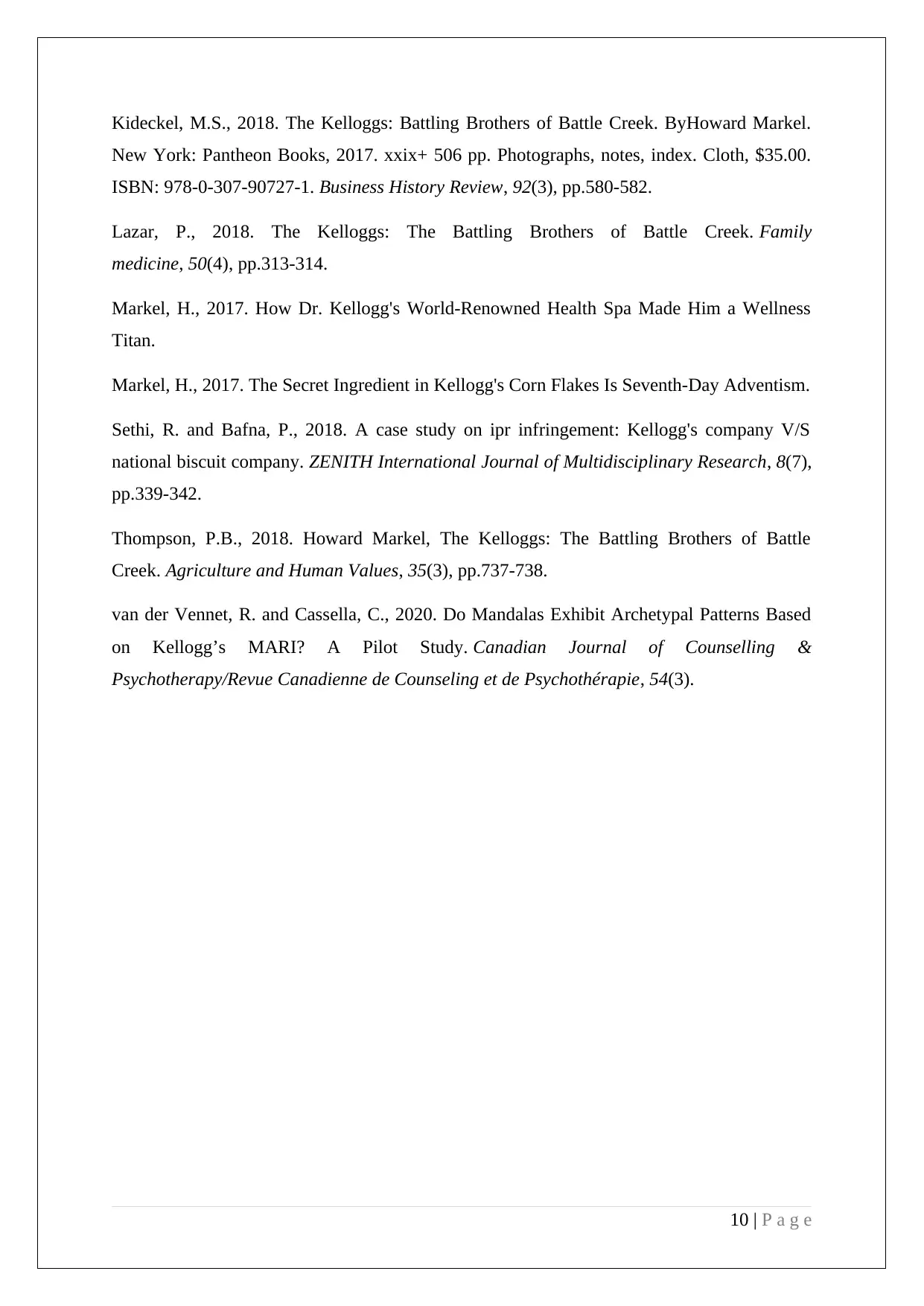
Kideckel, M.S., 2018. The Kelloggs: Battling Brothers of Battle Creek. ByHoward Markel.
New York: Pantheon Books, 2017. xxix+ 506 pp. Photographs, notes, index. Cloth, $35.00.
ISBN: 978-0-307-90727-1. Business History Review, 92(3), pp.580-582.
Lazar, P., 2018. The Kelloggs: The Battling Brothers of Battle Creek. Family
medicine, 50(4), pp.313-314.
Markel, H., 2017. How Dr. Kellogg's World-Renowned Health Spa Made Him a Wellness
Titan.
Markel, H., 2017. The Secret Ingredient in Kellogg's Corn Flakes Is Seventh-Day Adventism.
Sethi, R. and Bafna, P., 2018. A case study on ipr infringement: Kellogg's company V/S
national biscuit company. ZENITH International Journal of Multidisciplinary Research, 8(7),
pp.339-342.
Thompson, P.B., 2018. Howard Markel, The Kelloggs: The Battling Brothers of Battle
Creek. Agriculture and Human Values, 35(3), pp.737-738.
van der Vennet, R. and Cassella, C., 2020. Do Mandalas Exhibit Archetypal Patterns Based
on Kellogg’s MARI? A Pilot Study. Canadian Journal of Counselling &
Psychotherapy/Revue Canadienne de Counseling et de Psychothérapie, 54(3).
10 | P a g e
New York: Pantheon Books, 2017. xxix+ 506 pp. Photographs, notes, index. Cloth, $35.00.
ISBN: 978-0-307-90727-1. Business History Review, 92(3), pp.580-582.
Lazar, P., 2018. The Kelloggs: The Battling Brothers of Battle Creek. Family
medicine, 50(4), pp.313-314.
Markel, H., 2017. How Dr. Kellogg's World-Renowned Health Spa Made Him a Wellness
Titan.
Markel, H., 2017. The Secret Ingredient in Kellogg's Corn Flakes Is Seventh-Day Adventism.
Sethi, R. and Bafna, P., 2018. A case study on ipr infringement: Kellogg's company V/S
national biscuit company. ZENITH International Journal of Multidisciplinary Research, 8(7),
pp.339-342.
Thompson, P.B., 2018. Howard Markel, The Kelloggs: The Battling Brothers of Battle
Creek. Agriculture and Human Values, 35(3), pp.737-738.
van der Vennet, R. and Cassella, C., 2020. Do Mandalas Exhibit Archetypal Patterns Based
on Kellogg’s MARI? A Pilot Study. Canadian Journal of Counselling &
Psychotherapy/Revue Canadienne de Counseling et de Psychothérapie, 54(3).
10 | P a g e
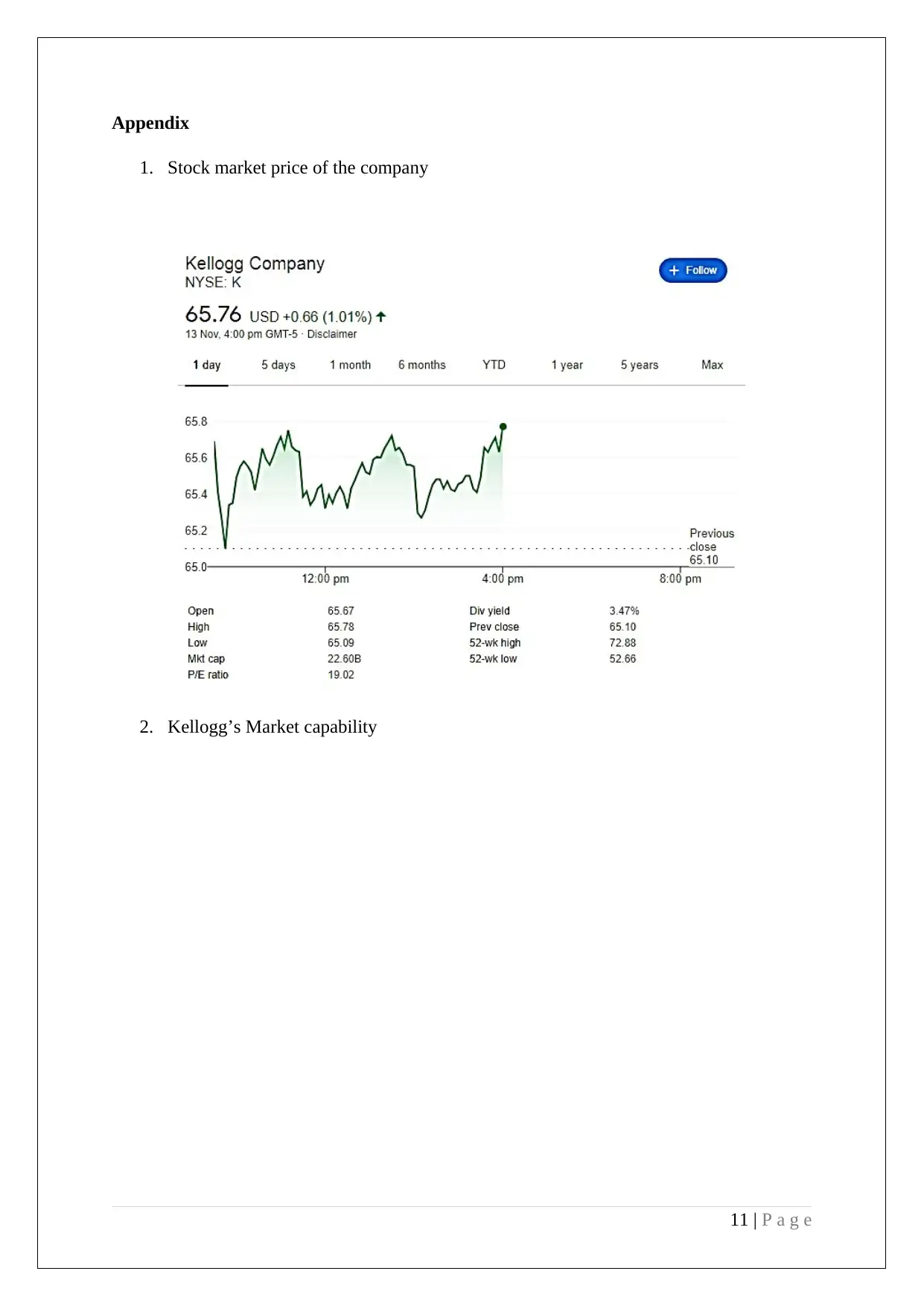
Appendix
1. Stock market price of the company
2. Kellogg’s Market capability
11 | P a g e
1. Stock market price of the company
2. Kellogg’s Market capability
11 | P a g e
⊘ This is a preview!⊘
Do you want full access?
Subscribe today to unlock all pages.

Trusted by 1+ million students worldwide
1 out of 13
Related Documents
Your All-in-One AI-Powered Toolkit for Academic Success.
+13062052269
info@desklib.com
Available 24*7 on WhatsApp / Email
![[object Object]](/_next/static/media/star-bottom.7253800d.svg)
Unlock your academic potential
Copyright © 2020–2026 A2Z Services. All Rights Reserved. Developed and managed by ZUCOL.





